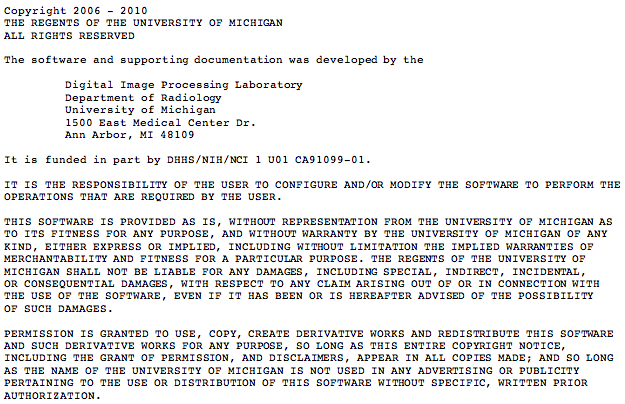Summary
The Lung Image Database Consortium image collection (LIDC-IDRI) consists of diagnostic and lung cancer screening thoracic CT scans with marked-up annotated lesions. It is a web-accessible international resource for development, training, and evaluation of computer-assisted diagnostic (CAD) methods for lung cancer detection and diagnosis. The following paper published in Medical Physics is effectively the authoritative user's manual for the database:
Armato SG III, McLennan G, Bidaut L, McNitt-Gray MF, Meyer CR, Reeves AP, Zhao B, Aberle DR, Henschke CI, Hoffman EA, Kazerooni EA, MacMahon H, van Beek EJR, Yankelevitz D, et al.: The Lung Image Database Consortium (LIDC) and Image Database Resource Initiative (IDRI): A completed reference database of lung nodules on CT scans. Medical Physics, 38: 915--931, 2011.
Important note: There was a "pilot release" of 399 cases of the LIDC CT data via the NCI CBIIT installation of NBIA. This LIDC-IDRI collection is the complete data set of all 1,010 patients which includes all 399 pilot CT cases plus the additional 611 patient CTs and all 290 corresponding chest x-rays.
If you use this data in your research please be sure that the LIDC/IDRI Database is mentioned in any publications or grant applications along with references to appropriate LIDC publications. Additional information about using this data as well as some collection meta data can be obtained in the Supporting Documentation below.
Data Access
Collection Statistics |
|
|---|---|
Modalities |
CT (computed tomography) |
Number of Patients |
1,010 |
Number of Studies |
|
Number of Series |
1,018 |
Number of Images |
|
You can view and download these images on the Cancer Imaging Archive by selecting the LIDC-IDRI collection. If you are unsure how to download this Collection view our quick guide on Searching by Collection or you can refer to our The Cancer Imaging Archive User's Guide for more detailed instructions on using the site.
Supporting Documentation
More information about the Cancer Imaging Program's Program Announcement for LIDC can be found at: http://imaging.cancer.gov/programsandresources/InformationSystems/LIDC
Reader Annotation and Markup
These links help describe how to use the .XML annotation files which are packaged along with the images in the Cancer Imaging Archive. The option to include annotation files in the download is enabled by default, so the XML described here will be included when downloading the LIDC-IDRI images unless you specifically uncheck this option.
- XML File Documentation
- Annotated XML File
- LIDC Radiologist Instructions for Spatial Location and Extent Estimates
Annotation and Markup Issues/Comments
- We recently (early 2009) discovered that, for a subset of cases, inconsistent rating systems were used among the 5 sites with regard to the spiculation and lobulation characteristics of lesions identified as nodules > 3 mm. We are in the process of correcting this situation. The XML nodule characteristics data as it exists for some cases will be impacted by this error.
- Also note that the XML files do not store radiologist annotations in a manner that allows for a comparison of individual radiologist reads across cases (i.e., the first reader recorded in the XML file of one CT scan will not necessarily be the same radiologist as the first reader recorded in the XML file of another CT scan).
- March 2010: Contrary to previous documentation, the correct ordering for the subjective nodule lobulation and nodule spiculation rating scales stored in the XML files is 1=none to 5=marked. The issue of consistency noted in issue 1 still remains to be corrected.
Nodule Size List
This link provides a list of available cases and the associated size of each identified nodule.
Diagnosis Data
For a limited set of cases, LIDC sites were able to identify diagnostic data associated with the case. Data was collected for as many cases as possible and is associated at two levels:
- Diagnosis at the patient level (diagnosis is associated with the patient)
- Diagnosis at the nodule level (where possible)
At each level, data was provided as to whether the nodule was:
- Unknown (no data is available)
- Benign or non-malignant disease
- A malignancy that is a primary lung cancer
- A metastatic lesion that is associated with an extra-thoracic primary malignancy
For each lesion, there is also information provided as to how the diagnosis was established including options such as:
- unknown - not clear how diagnosis was established
- review of radiological images to show 2 years of stable nodule
- biopsy
- surgical resection
- progression or response
You can download this Diagnosis Data at: LIDC Diagnosis Data-01-08-10.xls
Note: This data has not yet been updated to match the new patient ID structure for the LIDC-IDRI data set (it currently still uses the pilot data patient ID schema).
AIM Annotation Conversion Project
As part of an effort to move towards standard formats for annotation and markup a project has been undertaken to convert this data from the LIDC project into Annotated Image Markup format (AIM). AIM is a standard which was developed out of the caBIG program. More information about this effort can be found here on the NCI CBIIT wiki: LIDC Conversion to AIM
Software
MAX
MAX ("multi-purpose application for XML") performs nodule matching and pmap generation based on the XML files provided with the LIDC/IDRI Database. It also performs certain QA and QC tasks and other XML-related tasks.
MAX is written in Perl and was developed under RedHat Linux. It has been run under Windows.
Downloading MAX and its associated files implies acceptance of the following notice (also available here and in the distro as a text file):
DISCLAIMER: MAX is not guaranteed to process all input correctly. Possible errors include (but are not limited to) the inability to process correctly some types of nodule ambiguity (where nodule ambiguity refers to overlap between nodule markings having complicated shapes or to overlap between a nodule marking and a non-nodule mark).
Download the distro (max-V107.tgz); view/download ReadMe.txt (a text file that is also included in the distro).
